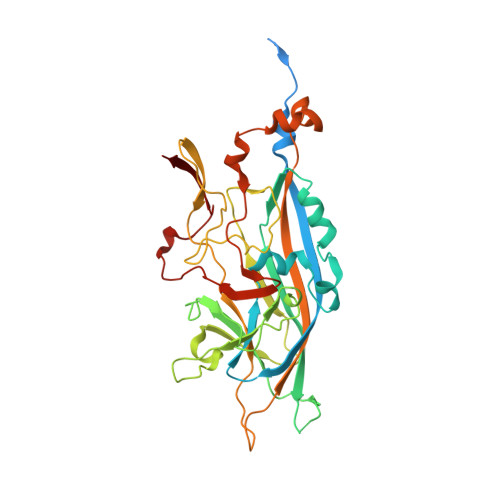Molecular biology and structure of a novel penaeid shrimp densovirus elucidate convergent parvoviral host capsid evolution.
Penzes, J.J., Pham, H.T., Chipman, P., Bhattacharya, N., McKenna, R., Agbandje-McKenna, M., Tijssen, P.(2020) Proc Natl Acad Sci U S A 117: 20211-20222
- PubMed: 32747554
- DOI: https://doi.org/10.1073/pnas.2008191117
- Primary Citation of Related Structures:
6WH3, 6WH7 - PubMed Abstract:
The giant tiger prawn ( Penaeus monodon ) is a decapod crustacean widely reared for human consumption. Currently, viruses of two distinct lineages of parvoviruses (PVs, family Parvoviridae ; subfamily Hamaparvovirinae ) infect penaeid shrimp. Here, a PV was isolated and cloned from Vietnamese P. monodon specimens, designated Penaeus monodon metallodensovirus (PmMDV). This is the first member of a third divergent lineage shown to infect penaeid decapods. PmMDV has a transcription strategy unique among invertebrate PVs, using extensive alternative splicing and incorporating transcription elements characteristic of vertebrate-infecting PVs. The PmMDV proteins have no significant sequence similarity with other PVs, except for an SF3 helicase domain in its nonstructural protein. Its capsid structure, determined by cryoelectron microscopy to 3-Å resolution, has a similar surface morphology to Penaeus stylirostris densovirus, despite the lack of significant capsid viral protein (VP) sequence similarity. Unlike other PVs, PmMDV folds its VP without incorporating a βA strand and displayed unique multimer interactions, including the incorporation of a Ca 2+ cation, attaching the N termini under the icosahedral fivefold symmetry axis, and forming a basket-like pentamer helix bundle. While the PmMDV VP sequence lacks a canonical phospholipase A2 domain, the structure of an EDTA-treated capsid, determined to 2.8-Å resolution, suggests an alternative membrane-penetrating cation-dependent mechanism in its N-terminal region. PmMDV is an observed example of convergent evolution among invertebrate PVs with respect to host-driven capsid structure and unique as a PV showing a cation-sensitive/dependent basket structure for an alternative endosomal egress.
Organizational Affiliation:
Institut Armand-Frappier, Institut national de la recherche scientifique-Institut Armand-Frappier, Laval, QC H7V 1B7, Canada.














